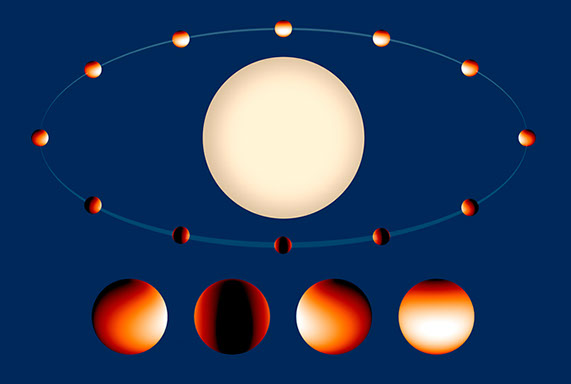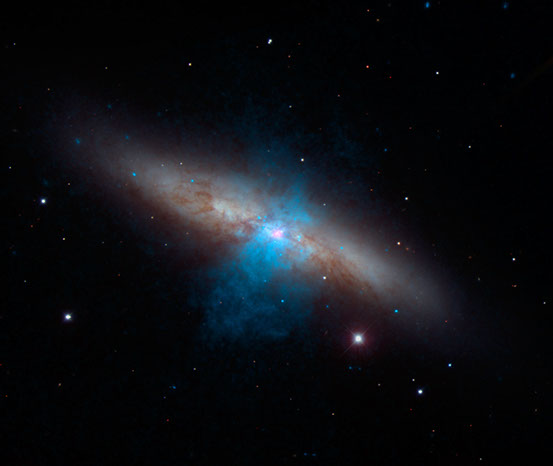

October 2014
Extreme Exo-planet
The Hubble Space Telescope has been investigating WASP-43b, a "Jupiter-size" exo-planet orbiting a star located 260 light-years away from us. The planet is too far away for even Hubble to directly photograph, but Hubble is able to use spectroscopy and break the light down into its component parts.
The planet can be observed as it passes in front of its star and the differences in the light from when the planet is in front of the star and when it is not in front of the star can be measured. The data from the star with no planet can be subtracted out of the data when the planet is present and the result can be attributed to the planet.
WASP-43b is about the same size as Jupiter but twice as dense. Unlike Jupiter, WASP-43b is very close to its sun and orbits once every 19 hours. The star is a an orange dwarf star and the planet is gravitationally locked to it like our moon is to Earth, so one hemisphere always faces the sun.
Using spectroscopy, the planet's light is divided into its component colors. From this, scientists can determine the amount of water and temperatures of the atmosphere. WASP-43b is an extreme planet. Temperatures on the daytime side of the planet are 2,800 degrees Fahrenheit. On the dark side they are just under 1,000 degrees Fahrenheit. The planet is so hot that all the water in the atmosphere is vaporized. The atmosphere is made up of primarily hydrogen gas. No surface features can be seen.
No planet in our solar system is like WASP-43b. Since the water in the atmosphere is being vaporized, we can measure that. WASP-43b has the same amount of water as an object with the same chemical makeup of our sun. By studying the amount of different elements in this planet and others, scientists can better understand how the planets were formed.

Image Credit: NASA/ESA
High-Energy Pulsar
NASA's Nuclear Spectroscopic Telescope Array (NuSTAR) has discovered a pulsar that has all the power of a black hole but with much less mass. The energy from the pulsar is equivalent to about 10 million suns. It is coming from M82, a galaxy 12 million light years away.
Scientists has previously detected ultraluminous X-ray sources (ULX's) coming from M82 but attributed it a black hole. ULX's are mysterious sources of high energy X-rays. It was thought that all ULX's were from black holes - until now. The ULX in M82 is pulsing. Black holes do not pulse. So this ULX is actually a pulsar.
A pulsar is formed when a giant star goes supernova and explodes. The remaining neutron star begins to shoot off beams of energy including X-rays. The neutron star begins to spin at a rapid rate and from our perspective here on Earth, it appears the energy is being shot out in pulses, thus the name pulsar. In reality, the energy is shot out in beams and as the star rotates we see the beam, then we don't, then we do - the same concept as a lighthouse - from sea the lighthouse light appears to flash, or pulse, but in reality it is a beam of light rotating around.
Scientists have identified two types of black holes, stellar black holes and supermassive black holes. Stellar black holes are formed in a massive supernova and supermassive black holes are found a centers of galaxies. Scientists have theorized that there must be a middle sized black hole and thought that ULX's might be them. This new discovery will make scientists revisit this theory.
The neutron star in M82 is shooting off X-rays with the energy 10 times of any previously known pulsar. The pulsar's pulse rate is 1.37 seconds. The neutron star has the mass of our sun but is only the size of a medium city - the entire star could fit onto the island of Manhattan.
NASA's Chandra X-ray space telescope and the Swift satellite have also monitored M82 and confirmed NuSTAR's finding that this energy is in fact coming from a pulsar. The mystery is how can such a small star produce such high energy. Like a black hole, the neutron star might be feeding on objects around it. But it is doing so at an extreme rate.
Astronomers will continue to investigate this pulsar in M82 using NuSTAR, Chandra and Swift as well as begin looking at other ULX's. This is another discovery that will deepen the mystery of black holes and other deep space objects.

The pulsar is seen at the center of the galaxy M82 and is shown in pink.
Credit: NASA/JPL-CalTech
Visit our sponsors.


For advertising opportunities on this page and our videos, contact
Upcoming Launches
Date: October 24
Launch Vehicle: Antares
Launch Site: Wallops Flight Facility, Virginia
Description: Deliver cargo and crew supplies to the ISS.
Date: October 29
Launch Vehicle: Soyuz
Launch Site: Baikonur Cosmodrome, Kazakhstan
Description: Progress 57 to deliver cargo and crew supplies to ISS.
Titan's Toxic Cloud
The Cassini spacecraft flying around Saturn and its moons has detected a toxic cloud at the south pole area on the moon Titan. Titan is the only moon we know of in the solar system that has an atmosphere. Like Earth, Titan has seasons, but each season on Titan lasts seven years. In the northern hemisphere it is now spring and in the southern hemisphere it is now fall.
The toxic cloud discovered is frozen particles of hydrogen cyanide. It is located about 200 miles (300 km) above the surface. For hydrogen cyanide to form into frozen particles, the temperature must be minus 234 F (-148 C). But theoretical models predicted that the temperature in that area should be 200 degrees warmer than that.
Looking a various data from Cassini including infrared spectrometer measurements, it was found that the temperature is dropping faster than expected as the season moves closer to winter.
Atmospheric circulation has been drawing large masses of gas towards the south pole since fall began. As the hydrogen cyanide becomes more concentrated, it further cools the atmosphere around it. Coupled with the fact that there is less and less sunlight there as winter approaches, the temperature drops further.
Due to Cassini's longevity, scientists are able to see and study the change of seasons on Saturn and Titan up close.
Mystery Feature on Titan
There is something in the Ligeia Mare, one of Titan's largest seas. It was not there in 2007 when Cassini snapped a photo of the sea. But in 2013, something was there. Cassini has now photographed the area again last month and the feature is still there, but it has changed.
The feature is large, covering an area of 100 square miles (260 sq km). What it is remains a mystery.
One explanation would be that the sea level has dropped. But if that were the case, then the shoreline in other areas would appear different. It could be waves, bubbles, something floating or perhaps something just below the surface. Or maybe it is something really exotic.
Over the period that these photos were taken, Titan has moved from winter to spring in the northern hemisphere. Perhaps this has something to do with the change in seasons. Scientists are hoping they can watch the area over then next few years and gain insight into this mysterious feature.

Credit: NASA/JPL-CalTech/ASI/Cornell
Monster Black Hole
Lurking in the dwarf galaxy M60-UCD1 is a black hole. Black holes are usually found at the center of galaxies, but this particular black hole is a monster at five times the mass of the black hole found at the center of the Milky Way while the galaxy M60-UCD1 is only 1/500 the diameter of the Milky Way. A large black hole in a tiny galaxy.
How did this come to be? M60-UCD1 is a dwarf galaxy to M60. Perhaps M60-UCD1 was once a large galaxy that came close to M60 and interacted. The large M60 started to pull stars and dark matter away from M60-UCD1 leaving the smaller galaxy we see today. If the original size of M60-UCD1 was around 10 billion stars, the black hole at the center would be the right size for that size galaxy. If most of the stars were then pulled away by M60, you would be left with a small galaxy with a large black hole.
It is believed that M60-UCD1 will eventually get completely merged into M60. If this happens, the black holes from each galaxy will also merge.
M60 and M60-UCD1 are about 50 million light-years away from us.
Disc Galaxy Formation
What kind of galaxy is created when two galaxies merge? Scientists have thought for decades that elliptical galaxies are formed with two galaxies merge. But new evidence shows that disc galaxies can be formed from merging galaxies.
Researchers using the Atacama Large Millimeter/sub-millimeter Array (ALMA) in Chile, along with eight other radio telescopes, have been observing 37 colliding galaxies in the nearby universe, 40 to 600 million light-years from Earth. Surprisingly, they found that these merging galaxies are forming disc galaxies, which include spiral galaxies like the Milky Way.
The team looked at the distribution of gas in the galaxies that are in their final stages of merging. By looking at the carbon monoxide emission they found direct evidence that the merging galaxies are forming into disc shaped galaxies. This is the first time observational evidence has been gathered for disc formation in merging galaxies.
This study may provide insight into how our own Milky Way formed. The researchers plan to look at merging galaxies further out and begin to look at star formation in these newly merged galaxies.
© 2014-2016 Ted Cook Productions LLC. - All Rights Reserved